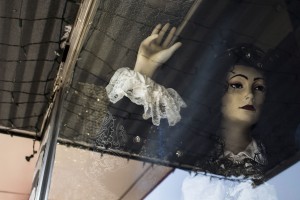Faculty Presentations, Part 2:
Kim Garza– Assistant Professor of Graphic Design, 5 years at St. Edward’s
Kim Garza took us through the common procedures of different areas of the graphic design field, and she used personal examples and projects in order to specify the journey of a product. She stated that she loves the field of design because of the many, many opportunities that come through it. “Design”, she quoted, “is liberal arts for life”, and a designer is always involved in new learning.
The app she worked on and described, titled Eventurist, came to be through interviews and research, where they were able to identify and justify a need and types of users. I found it interesting that in order to fully understand the user experience and take their personal focus out of the picture, they created personas based on the research. From 15 ideas came 4 prototypes, and those prototypes went through 8 user tests, which eventually
Her “creative pursuit” (the video with musical and visual elements and manipulation) with her husband was brilliant, transporting, and multi-dimensional. I really enjoyed it, and I found it funny that their ability to use the old film “Till the Clouds Roll By” was a result of a copyright error. Once we began to watch and listen to it, it revealed a more eerie and ghostly tone due to the music and visuals created to replace the originals. It is also amazing that this has been a project of theirs for 6 years because it shows that one can put their passion anywhere and, usually, at anytime. I enjoyed how she shared multiple sides of her career and passion for design.
Tammie Rubin– Art Department
Tammie Rubin noted the influence of the term “chimera” and its importance of the interpretation of the term (as mythological creature and as something that is wished/hoped for) throughout her work, which I thought was very fascinating because I was then able to see this influence as she further shared her work and delved into new concepts.
She also was influenced by her upbringing in the urban, nature-controlling environment of Chicago. She had a “specific and guided relationship” with nature because of this environment, which changed when she moved to Seattle. Although she thought this change of interaction and scenery would help her develop new behaviors and feelings towards nature, she realized that she wouldn’t change, and that she was even more interested in the idea of “manufactured nature” and the contrasts of waste and beauty (rather than solely focusing on the beauty of nature). She liked looking at the details and intricate textures of the plastic and how it would all be waste someday (only used for a moment).
I liked her thought process behind her choice of using the acrylic paint; it gave her pieces a plastic feel that delayed the viewers’ definitions and perceptions of the pieces. They would have to get closer, and, in turn, focus more mentally on her pieces. She had so many interesting insights towards things, such as the observation that we ascribe power to simple objects and sort of create an imagined contraption beyond our world.
James Scheuren– Photography and Photo-communications
James Scheuren’s work was also heavily inspiring (like Tammie and Kim’s!) towards the different possibilities and interpretations that can exist in and, in some ways, shake perceptions of the world. I like his focus on human things done by accident with no aesthetic intention or purpose. He described it as a “very human” intention, however, and places the beauty within this fact and through the capture of the act within his camera frame. The photograph itself “conveys the importance”.
I also liked the idea that sort of repeated throughout his works (such as “Red Room”, “Sticker”, and the piece with the painted over constellations) of what we are willing to put up with and live with. Many of these ideas wove in and out of his pieces, and really pull at the essence of human natures and behaviors (“channeling the unconscious”).
I really enjoyed when he began talking about the personal connections of leaving childhood (“Childhood’s over, asshole”) as seen through the crickets caught in the sticky trap. While I wouldn’t have known this connection as directly without him telling us, I would sense that feeling of loss and preservation at once.
What I love about these artist/faculty talks is that they introduce the building connections that they’ve noticed and briefly explain their personal interpretations before, during, and after making their pieces. Their words expand our understanding and allow us to not just look through their eyes, but to view it through a perspective of heightened senses and comprehension.



















